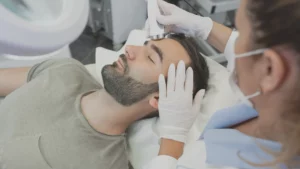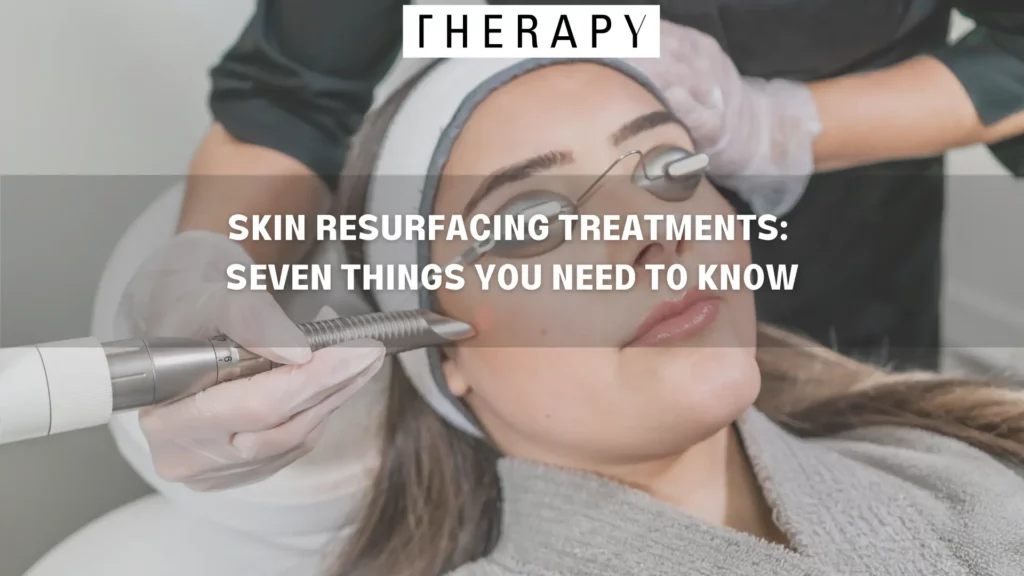Skin Resurfacing Treatments: Seven Things You Need to Know
When it comes to beauty and self-care, Therapy Hair Studio doesn’t just stop at luxurious locks. We can also keep your skin healthy and radiant with resurfacing treatments. Dive deep with us as we demystify the wonders of these revolutionary procedures. From their transformative powers to the magic behind the process, we’ve compiled seven essential things everyone in Houston needs to know before scheduling a treatment.
#1 What Are Skin Resurfacing Treatments?
According to the American Board of Cosmetic Surgery, skin resurfacing is a cosmetic procedure that rejuvenates the skin by removing its outermost layers. Through various techniques like lasers, chemical peels, or microdermabrasion, these treatments address imperfections such as wrinkles, scars, and discoloration. By promoting the growth of new, healthier skin cells, skin resurfacing leaves you with a smoother, more radiant complexion.
#2 Different Types of Skin Resurfacing Treatments
Skin resurfacing boasts a variety of treatments tailored to individual needs:
- Laser Resurfacing: Uses focused beams of light to target and eliminate damaged skin cells.
- Chemical Peels: Involves applying a chemical solution to peel away the skin’s top layers, revealing fresh skin beneath.
- Microdermabrasion: A minimally abrasive technique using tiny crystals to exfoliate the superficial layer of dead skin cells.
- Dermabrasion: A more intensive procedure that sands down the skin to improve its texture and appearance.
#3 Who’s a Good Candidate for Skin Resurfacing Treatments?
Skin resurfacing is a transformative journey, but it’s essential to know if it’s right for you. Ideal candidates typically:
- Have Realistic Expectations: Understanding the potential outcomes ensures satisfaction post-treatment.
- Possess Good Skin Health: Those without active breakouts or severe skin conditions can achieve the best results.
- Aim to Address Specific Concerns: Whether it’s fine lines, age spots, scars, or uneven texture, having a clear goal aids treatment selection.
- Are Non-Smokers: Smoking can hinder the healing process.
- Are Committed to Post-Treatment Care: Proper skincare after treatment is crucial for optimal results.
#4 Potential Complications from Skin Resurfacing Treatments
While skin resurfacing treatments offer promising results, being aware of potential complications is crucial. Many people experience redness and swelling after a treatment, which usually subsides after a few days. However, prolonged symptoms might hint at more severe complications. In rare instances, the treatment can result in raised or keloid scars. There’s also the risk of infection due to breaks in the skin, necessitating medical attention.
Some individuals may experience changes in skin coloration, either darkening (hyperpigmentation) or lightening (hypopigmentation). Those with a history of herpes around the mouth should be aware that treatments sometimes reactivate cold sores. Lastly, some laser treatments, if not administered correctly, can lead to burns or blistering.
#5 How Much Do Skin Resurfacing Treatments Cost?
What you’ll pay for skin resurfacing often hinges on the treatment you opt for. For instance, laser resurfacing is usually more expensive than something like microdermabrasion, though it might require fewer visits. Another pivotal factor is the practitioner’s experience. Seasoned professionals with a sterling reputation typically charge a premium for their services. Lastly, the treatment’s extent will influence the final cost.
#6 How Long Do Skin Resurfacing Treatments Last?
Generally, results from treatments like laser resurfacing or deep chemical peels can last several years. However, the more subtle effects of microdermabrasion or light chemical peels may require touch-ups every few months. Furthermore, individual lifestyle choices play a significant role. Those who prioritize sun protection, maintain a rigorous skincare routine, and lead a healthy lifestyle can expect prolonged benefits. Conversely, habits like smoking or excessive sun exposure can diminish results.
#7 How to Choose a Skin Resurfacing Treatment Provider
 Selecting the correct skin resurfacing provider is paramount to ensuring your safety and desired results. Here are some steps to guide your decision:
Selecting the correct skin resurfacing provider is paramount to ensuring your safety and desired results. Here are some steps to guide your decision:
- Check Qualifications: Ensure the provider has relevant certifications and training specific to the treatments they offer.
- Read Reviews and Testimonials: Previous client experiences can provide insights into the provider’s expertise and customer service.
- Ask for Before-and-After Photos: This allows you to gauge the provider’s skills and set realistic expectations for your own treatment.
- Consider the Consultation Process: You should have a thorough consultation with your provider, where they assess your skin care needs, discuss potential risks, and recommend suitable treatments.
- Assess the Facility: A clean, modern facility with up-to-date equipment indicates a commitment to quality and the latest advancements.
- Inquire About Post-Treatment Support: A good provider will offer guidance on aftercare, ensuring the longevity of your results.
- Trust Your Instincts: Feeling comfortable and confident in your provider is crucial.
At Therapy Hair Studio, our team is dedicated to excellence, prioritizing your safety and well-being, and ensuring you’re happy with your treatment. We’re here to help your skin look its best, so call (713) 355-4247 today or complete our contact form to schedule an appointment.
Related Posts:






